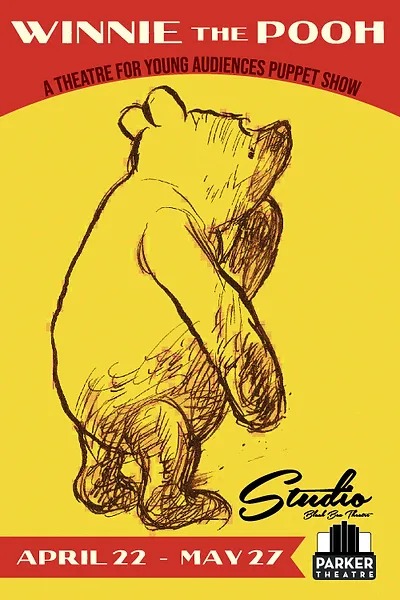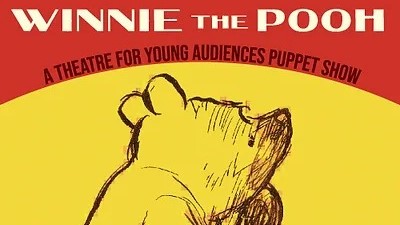SOUTH SALT LAKE — For nearly a century, readers and audiences have been pulled into the Hundred Acre Wood of A. A. Milne’s imagination. Known characters such as Piglet, Tigger, Eyeore and, of course, Winnie the Pooh have resonated with generations for the simplicity of the stories these loveable characters find themselves in. The Parker Theatre’s Winnie the Pooh (adapted and directed by Madeline Thatcher and Larissa Anderson) had all the hallmarks of a great puppet show coupled beautifully with excellent design choices, and nostalgia for a bygone period. However, the production lost steam part way through and struggled to remain engaging for a full hour of puppetry.

For this production in the Parker Theatre Studio, audience members had the option to sit in chairs around the thrust stage or sit on green carpet on the stage to be closer to the actors and puppets. The proximity began as a great tool to engage the audience. Children were invited a couple of times in the show to make sound effects, and I was particularly impressed with how the actors were calm and collected, even as toddlers attempted to wander across the stage and were scooped up by alert parents. This was particularly true for Milo Stebbing, whose Christopher Robin had to move back and forth between puppeting behind a puppet show façade and coming out front to engage with the narrator (played by Sean Sweeney). Stebbing was poised and charismatic as the child Christopher Robin and projected well when puppeteering. For a child his age, it was an impressive bit of acting. Moreover, Stebbing’s look and persona captured the essence of the iconic Chistopher Robin.
The puppets were functional and fun. Each puppet was beautifully hand drawn on flat cardstock with the moving parts attached to rods and interconnected with brass brads. The sheer novelty of seeing the puppets piqued my curiosity and the curiosity of my 3-year-old son, who fit in with a gaggle of other children his age sitting on the stage. It was especially engaging to see Christopher Robin go from being a human child to running around back and suddenly coming to life as a puppet with the other puppets. (The narrator smartly explained at the beginning how the puppets would work and that it was ok to see the hands of actors at times.)
The overall work of the puppeteering was very strong and is a credit to actors Trevor Bird, Laurel Morgan, Taylor McKay Barnes, and True Leavitt, all of whom had clearly mastered the technique and finesse of manipulating the puppets to tell the story. Several of the scenes involved some very intricate puppet work, particularly for the style of puppetry used. For example, during the nightmare where Pooh cannot sleep and begins to count Hefalumps, shadow puppets in the shape of elephants Hefalumps came from a variety of angles.
The lighting was also brilliantly executed, (though the designer is uncredited in the program). Not only were various weather elements shown with lightning, flooding, and days turning to nights, but when Pooh was disoriented, the gobo effects of light spiraling were fun and engaging.
Where the production ultimately fell was in failing to take into account how little contemporary children are used to puppets, and how much more opportunity puppets present when breaking the fourth wall. Anderson’s script lacked depth and the ability to take advantage of the opportunities that puppets offer in theatre for young audiences. The relationship between Christopher Robin and the narrator was unclear, though I think the narrator was supposed to serve as a de factor father figure for the boy. Also unclear was the context of being invited into their storytelling session.
The show also moved crisply between many well known Pooh stories, such as Eyeore’s Birthday, the Rainstorm, trying to catch a Hefalump, and so forth. However, there was little to offer beyond the novelty seeing the puppets for the audience. The script did not allow for the kinds of play that other productions (such as Go, Dog. Go!) offer to their very young audience. One problem was that direction did little to keep young audiences involved in understanding or making the story. Instead of wildly creative or innovative way to tell the Winnie the Pooh story (now possible with the characters entering the public domain), the audience instead got actors blitzing from one story to another.
Yet, so much of what the show did worked. I still left impressed by the production values as I have at every Parker show I have seen. And the dynamic vocal acting of each of the puppeteers was phenomenal. However the show’s script moved mechanically from one Pooh story to another and asked rhetorical questions rather than allowing the actors and audience to truly engage one another as the best puppet shows always do. I think it was a lovely show that tried to cram in a little too much of the nostalgic Pooh without adapting fully for a modern audience, young or old.
[box]The Parker Theatre production of Winnie the Pooh plays Saturdays at 11 AM and 1 PM at the Studio Theatre (3605 South State Street, South Salt Lake) through May 27. Tickets are $8-10. For more information, visit parkertheatre.org.[/box]

